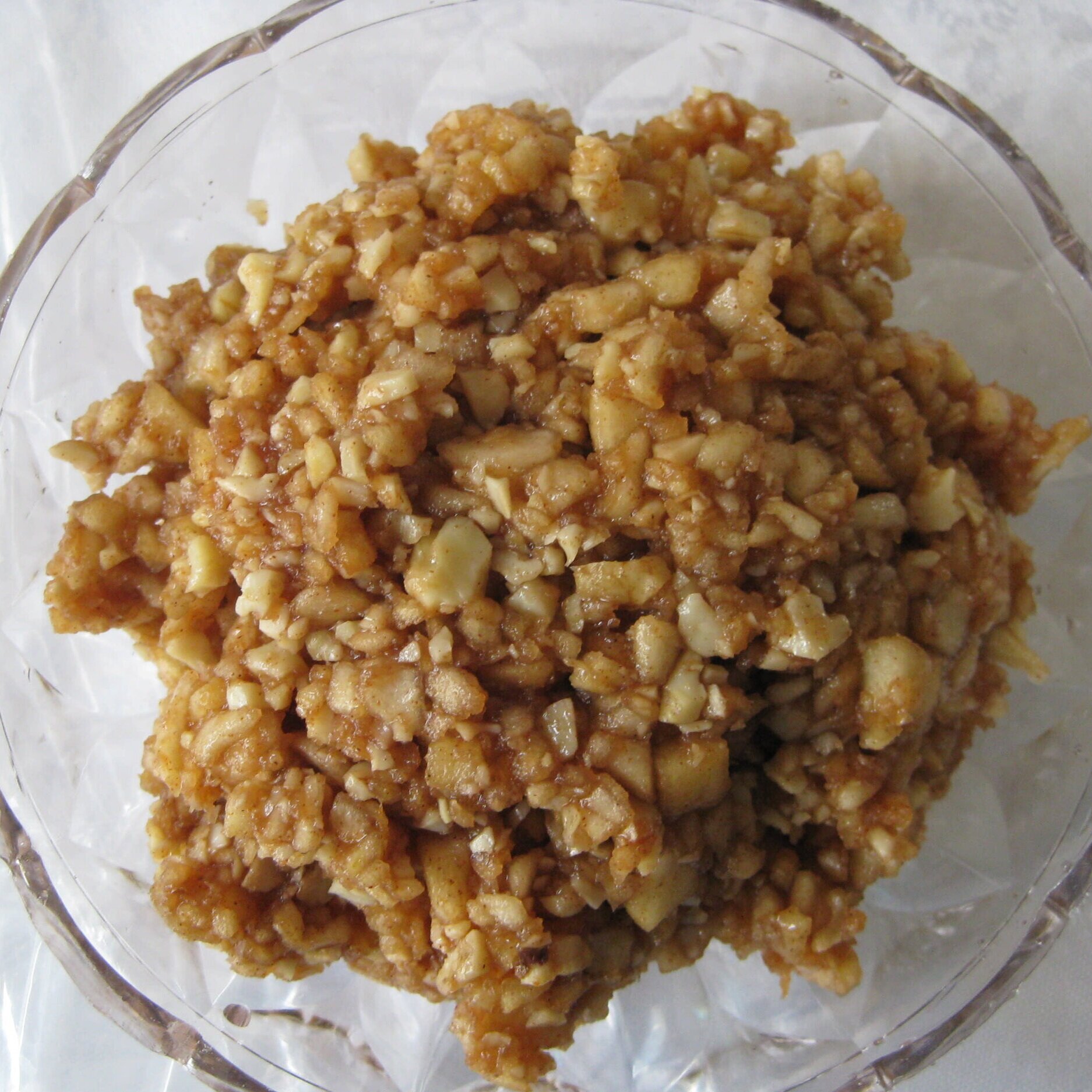This delicious recipe comes to us courtesy of veteran Delicious Israel guide Ilana Butrimovitz, who recently traded in the hustle and bustle of Tel Aviv (along with some good waves) for a serene quarantine life in Kibbutz Mevo Hama in the Golan Heights.
One of my favorite childhood memories from the Passover seder (besides receiving Samantha the American Girl doll as a prize for finding the afikoman while my brother was under the table tying guests’ shoelaces together!) was that first bite of the sweet charoset in the traditional ‘Hillel’s sandwich.’ After patiently waiting through the entire telling of the full story of the Jews’ exodus from Egypt, that first bite always gave me hope that we were getting close to the real meal.
Charoset tradionally represents the mortar that the Israelites used to make bricks while enslaved in Egypt. It adds sweetness to our seder plate, traditionally eaten with the customary bitter herb. This mixture represents the combination of the bitterness of slavery with the sweet taste of freedom.
Recipes for charoset have been passed down from generation to generation, crossed oceans, survived wars - and in recent years have been revised for the modern palate. In fact, Ben and Jerry’s even launched a special edition charoset-flavored ice cream!
The Talmud says that charoset should be made of the fruits that greeted the Israelites when they came into the land of Israel. Apples, pomegranates, figs, dates, nuts and almonds are all mentioned in the biblical Song of Songs, and are often found in charoset varieties.
Jewish cultures in the diaspora have taken this unique culinary tradition in many different directions. While unfortunately we are not able to travel right now, we can still experience the flavors of the world through charoset across the world from the comfort of our homes! This year, may charoset add some sweetness to your quarantine.
Please note that there are many different variations from each culture - the wonders of tradition! The following are just a few examples. We would love to hear if your family has other traditions and where they are from.
Ilana’s Bubbie’s Ashkenazi Charoset Recipe
Photo courtesy of OU Kosher
This recipe is near and dear to my heart, as it comes from my Bubbie (grandmother) on my father’s side. This Ashkenazi (Eastern European Jewish) style charoset is very common in the United States, and shines in its simplicity. The apples and cinnamon really stand out her, and you can expect a coarser, chunkier texture rather than a smoother paste.
Ingredients
3 apples, unpeeled
1 tsp. cinnamon
1 ½ cup ground walnuts
3 tbsp. sweet red wine (If you only have regular red wine, add some extra sugar)
Honey or sugar to taste
Instructions
Chop apples by hand into small pieces, or in a food processor if you prefer a finer mixture.
Add cinnamon, walnuts, wine and honey/sugar. Adjust ingredients to personal preferences if desired.
Chill in fridge for at least 1 hour (overnight preferred)
Recipe yields 10-12 servings.
Ilana’s Grandma’s Iraqi Charoset
Photo courtesy of Afooda
Iraq (Babylonia in ancient times) was home to Jews since the destruction of the First Temple in the 6th century BCE, and was until the mid-20th century. Dates, rather than apples, were their native fruit. Dates are also known as one of the seven fruits of the holy land. When Israel is referred to as the land of milk and honey in the bible, it is speculated that the honey most likely referenced date honey, as there were no bees when the Israelites entered the land.
Iraqi charoset is famous for dates, and the following recipe is one of the simpler ones - my great-grandmother used to boil down the dates, which is a very long process. But since I can remember, my family has just been buying the date syrup (known as silan here in Israel) and it is just as tasty! It really is a piece of heaven - I even just eat it with a spoon.
Ingredients
1 cup walnuts
1 cup date honey (silan)
Instructions
Chop the nuts into about ¼-inch (6-millimeter) pieces, before texture becomes powder-like.
Put the date honey in a small bowl and stir in the nuts. You should have a thick honey-like spread.
This recipe can be made one day ahead and stored, covered, at room temperature.
Persian/Iranian Charoset
Image courtesy of Twice Cooked
Persian food is all about the aromas. Persian/Iranian charoset (also known as Hallaq) reflects the many fruits and spices of what was called Persia until 1935 - Iran! It also often sees the inclusion of dates, bananas, pears, oranges and other fruits grown in the area. There is apple in this recipe like in the Ashkenazi one above, but the emphasis is really much more on the bananas and the pears. I particularly love the addition of cardamom, which adds an extra depth and warmth to an already comforting and delicious dish.
Recipe sourced from The New York Times
Ingredients
1 cup almonds
1 cup roasted, shelled pistachios
1 cup walnuts
1 cup black raisins
1 cup golden raisins
1 cup dates, pitted
2 tsp. cinnamon
2 tsp. ground cardamom
1 tsp. ground ginger
½ tsp. ground nutmeg
1 large apple, peeled, quartered and cored
1 large pear, peeled, quartered and cored
2 bananas, peeled
2-3 tbsp. apple cider vinegar
½ cup - 1 cup pomegranate juice
½ cup - 1 cup sweet kosher wine
Instructions
1. In a large food processor, combine nuts, raisins, dates and spices. Pulse until nuts are coarsely chopped.
2. Add apple, pear and bananas, and pulse until coarsely chopped.
3. Add 2 tbsp. apple cider vinegar, ½ cup pomegranate juice, and ½ cup wine. Pulse again, adding more vinegar, juice or wine to taste as needed to make a coarse paste. Do not purée - mixture should retain some crunch.
Recipe yields 6 cups charoset.
Moroccan Charoset Balls
Photo courtesy of MarocMama
Moroccan Jews know how to do food right - in the most festive and colorful way. At the end of Passover they throw a big (leavened) feast called Mimouna, which has been celebrated in Morocco since the 16th century. Traditionally, Moroccan Jews would give all of their leftover leavened products (flour, grains etc.) to to their Muslim neighbors before Passover. In exchange, their Muslim neighbors would bring them lots of cakes and cookies when Passover was over! This was usually accompanied with tons of singing and dancing.
So it is only natural that the Moroccans would do the seder right as well! The prunes in this recipe really give it a much deeper taste than other charosets, but what really stands out is that this delicious paste is made into balls rather than left as a spread. What doesn’t taste better bite-sized?!
Ingredients
8-10 dried, pitted prunes
6-9 pitted dates
¼ cup golden raisins
1 tsp. ground cinnamon
½ cup almonds
4 tbsp. raw honey
2-3 tbsp. grape juice or kosher wine (reserve for end)
Sugar (optional)
Finely ground almond flour to roll the charoset into balls
Instructions
It is very important to pit the dates and prunes used in this recipe. So take a minute to make sure they are pitted before getting started!
The next step is really easy - simply toss everything into a food processor and blend it together.
After you've mixed everything, have a taste. If the mixture is really thick, add some grape juice or kosher wine. If it tastes too bitter, add a little bit of sugar. That being said - this is not meant to be overly sweet.
To roll the charoset balls, take a piece of the mixture about the size of large olive and roll into a ball.
Next, roll it in the ground almonds and set aside.
Continue with the remaining mixture until it has all been used. To store, keep in a cool place, but don't refrigerate, in a tightly sealed container.
Recipe yields 12-20 balls, depending on size
Indian-Style Charoset
Indian Jews have a very deep connection to their country, while also maintaining their Jewish heritage and traditions. The result? Jewish customs infused with the flavors of local cultures. The wine vinegar in this recipe turns this charoset into a chutney-like dish, and the blending of sweet and sour adds a very unique dimension. Given the not-too-sweet nature of this charoset, we would suggest saving some of this as a side to your chicken or beef as well.
Recipe courtesy of Jamie Geller
Ingredients
2 ripe mangos, medium-diced
¼ cup dark raisins
¼ cup pitted dates
¼ cup slivered almonds
¼ cup sugar
2 tablespoons red wine vinegar
Pinch of kosher salt
Instructions
Pulse mangos, raisins, dates, almonds, sugar, vinegar and salt in a food processor until they form a paste. Alternatively, you can chop the ingredients very finely with a sharp knife.
This charoset can be made 3 days before serving and can be stored, covered in the refrigerator.
Italian Charoset
The history of the Jews in Italy spans more than 2000 years. How Italians survive a week of Passover without pasta or pizza is beyond me! In Italy, there are many different charoset recipes from different regions of the country. Many of them include either chestnuts of pinenuts, and there is a srong emphasis of the option of substituting grape juice for wine - they must keep the wine for drinking!
The following recipe is from the region of Padova (Padua).
Recipe courtesy of DinnerInVenice
Ingredients
1 lb. apple slices, peeled
¾ lb. boiled chestnuts, peeled
½ lb. walnuts, shelled
½ pound pitted dates
½ pound dried apricots
½ pound raisins
2 small bananas
1 small seedless orange, only the pulp
½ tsp. cinnamon
½ teaspoon cloves (optional)
Instructions
Put everything in the blender and process until combined, but not too smooth.
Cook on a low flame for 15 minutes, stirring. Add some sweet wine or grape juice just before serving.
Alternative Charoset: The Mexican Cocktail
Skip the 4 glasses of wine and go straight to this delicious, Mexican charoset-inspired drink!
Recipe courtesy of Rosa Mexicano, an NYC Mexican restaurant that hosts an annual Passover week!
This recipe yields 1 cocktail. If you would like to double up (we won’t judge), simply double the recipe!
Ingredients
1½ oz. Herradura Silver Tequila
½ oz. apple juice (use any natural, unfiltered or cold-pressed 100% apple juice like RW Knudson)
¾ oz. fresh, hand-squeezed lemon juice
½ oz. cinnamon syrup (make your own by dissolving sugar with water and cinnamon)
½ oz. honey syrup (2 parts honey mixed with 1 part warm water)
¼ oz. Manischewitz wine reduction (sweet kosher wine boiled down to a syrup)
Garnish of three apple slices, each ⅛-inch thick, fanned and skewered on a bamboo prism pick (ok, we won’t tell anyone if you don’t fan and skewer them!)
Instructions
Combine all ingredients except Manischewitz reduction in a cocktail shaker, and shake vigorously with ice.
Strain over fresh ice in a 10 oz. rocks glass or another glass of your choosing.
Drizzle Manischewitz reduction carefully on top of drink. It should not combine, but gently swirl in to add color.
Garnish with apple slices.
Whatever charoset you decide to make (or try making them all next year), we wish you a very sweet and happy passover! Show us your recipes on Instagram by tagging @deliciousisrael or on our Delicious Community group on Facebook!






